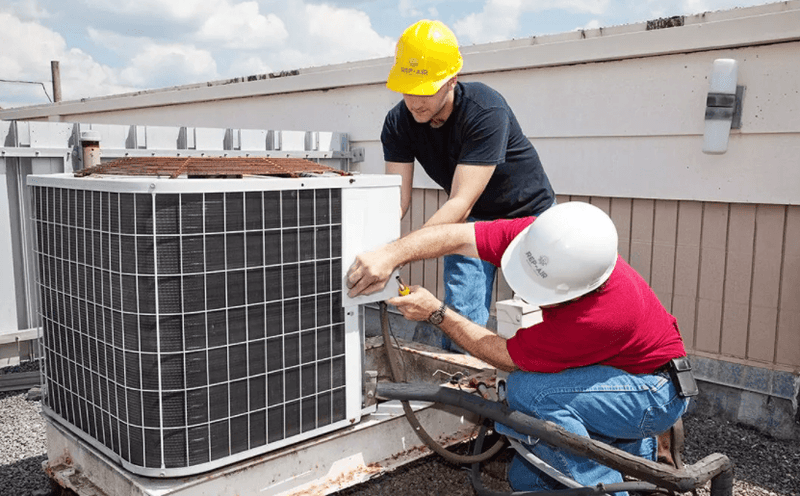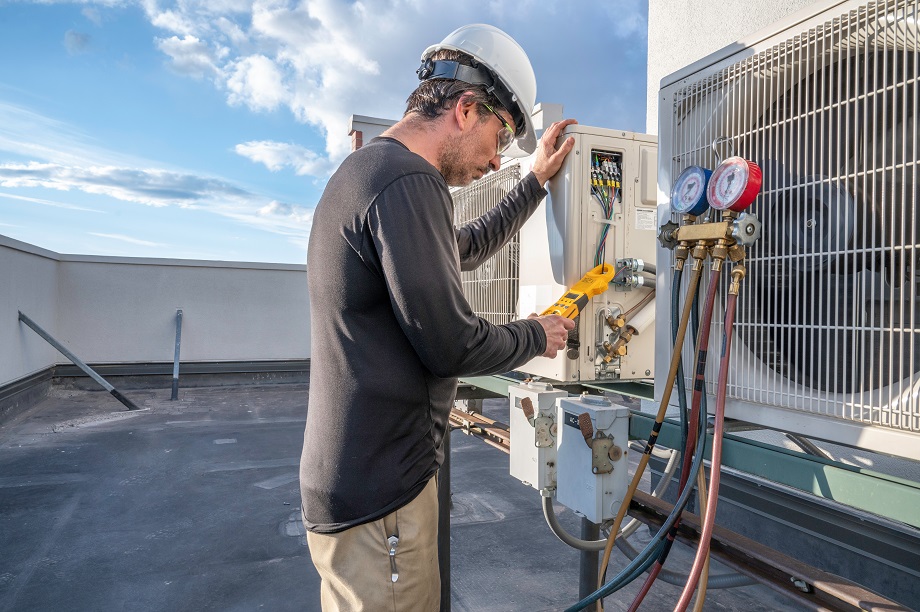Checking Out the Necessary Components of an Efficient HVAC System
A reliable a/c system is improved several essential elements that work in consistency. Each part, from the thermostat to the ductwork, plays an important duty in preserving comfort and energy performance. Comprehending these components is essential for enhancing performance and improving interior air quality. As one takes a look at these components, the complex relationships in between them expose insights into improving overall system efficiency. What specific variables add most to this performance?
The Role of the Thermostat in Heating And Cooling Performance
Although often ignored, the thermostat plays a crucial function in the performance of heating and cooling systems. HVAC experts. This small device serves as the main nerve center, managing temperature settings and guaranteeing suitable convenience within a space. By precisely picking up the ambient temperature level, the thermostat connects with the heating, air flow, and air conditioning units to maintain the desired climate
An efficient thermostat decreases energy consumption by turning on the cooling and heating system only when necessary, therefore avoiding excessive home heating or cooling. Modern wise and programmable thermostats enhance this performance additionally by enabling users to establish schedules and from another location readjust settings, adapting to everyday regimens.
In addition, the placement of the thermostat is necessary; improper place can result in imprecise temperature analyses, causing inefficient procedure. In general, a well-functioning thermostat not just boosts convenience but likewise contributes significantly to power financial savings and the longevity of the HVAC system.
Comprehending the Relevance of Air Filters
Air filters serve an essential feature in heating and cooling systems by ensuring that the air distributing within a room continues to be healthy and balanced and tidy. These filters catch dirt, allergens, and other pollutants, preventing them from being recirculated throughout the environment. By capturing these particles, air filters contribute to improved interior air quality, which can greatly profit owners' wellness, specifically those with allergic reactions or breathing conditions.
Furthermore, maintaining clean air filters enhances the efficiency of HVAC systems. Clogged filters can limit airflow, causing the system to function more challenging to maintain wanted temperature levels, bring about raised energy consumption and greater utility bills. On a regular basis replacing or cleaning filters is an essential maintenance step that can lengthen the life expectancy of heating and cooling equipment. Inevitably, comprehending the importance of air filters permits home owners and structure supervisors to take proactive procedures to guarantee a well-functioning, reliable heating and cooling system that advertises a secure and comfortable interior atmosphere.

The Capability of the Heater and Heatpump
Heaters and heatpump are important components of HVAC systems, accountable for supplying warmth during cooler months. Furnaces operate by home heating air via combustion or electric resistance, then dispersing it throughout the home via ducts. They typically use quick heating and can be fueled by all-natural gas, electrical power, or oil, relying on the system type.
On the other hand, heat pumps transfer warmth instead of create it. They draw out heat from the outside air or ground, also in low temperature levels, and transfer it inside. HVAC experts. This double capability enables heatpump to additionally offer cooling in warmer months, making them flexible alternatives for year-round environment control
Both systems call for correct upkeep to assure efficiency and longevity. While furnaces master extreme cool, heatpump can be helpful in modest climates. Comprehending their unique functionalities help property owners in choosing the most suitable alternative for their home heating needs.
Discovering the A/c Unit
The a/c system is an essential element of cooling and heating systems, available in numerous types to fit different requirements. Understanding the efficiency scores of these units is vital for making informed selections regarding energy consumption and cost. This section will explore the diverse types of ac system and clarify just how performance rankings influence efficiency.
Kinds of Air Conditioners
While numerous factors influence the choice of a/c systems, recognizing the various kinds available is critical for home owners and structure supervisors alike. Central air conditioners are designed to cool entire homes or buildings, using a network of ducts for air movement. Home window systems use an even more local option, perfect from this source for solitary areas Discover More or small rooms. Portable air conditioners supply versatility, allowing users to relocate the unit as needed. Ductless mini-split systems are another alternative, integrating the efficiency of central systems with the comfort of zoning, as they call for no ductwork. Geothermal systems harness the earth's temperature level for energy-efficient cooling. Each type features unique benefits, making educated options important for reliable environment control.

Performance Ratings Described
Understanding performance rankings is crucial for choosing the ideal cooling system, as these metrics give insight into the system's efficiency and power consumption. One of the most usual score for a/c is the Seasonal Energy Performance Ratio (SEER), which measures the cooling result during a regular air conditioning season divided by the complete electric energy input. A greater SEER indicates far better performance. Furthermore, the Power Performance Proportion (EER) is used for measuring performance under details conditions. Another important metric is the Energy Celebrity accreditation, which represents that a system satisfies strict power performance standards. By assessing these ratings, consumers can make enlightened choices that not just optimize convenience but also lower energy costs and environmental effect.
The Significance of Ductwork and Airflow
Reliable ductwork style and air movement management play vital functions in the general effectiveness and performance of cooling and heating systems. Proper ductwork guarantees that conditioned air is dispersed uniformly throughout an area, minimizing temperature changes and enhancing convenience. Well-designed air ducts minimize resistance to air flow, minimizing the workload on heating and cooling devices and inevitably decreasing energy usage.
Air flow monitoring involves purposefully positioning vents and registers to improve the circulation of air. This prevents common concerns such as warm or chilly spots, which can take place when air flow is obstructed or improperly balanced. In addition, the ideal duct products and insulation can even more boost effectiveness by reducing warmth loss or gain during air transportation.
An efficient ductwork system not just adds to power financial savings yet can also lengthen the life expectancy of heating and cooling tools by decreasing unneeded strain (HVAC experts). Subsequently, understanding the value of ductwork and airflow is important for attaining peak heating and cooling system efficiency
Routine Upkeep Practices to Enhance Efficiency
Routine upkeep techniques are important for guaranteeing peak performance of a/c systems. These methods consist of routine assessments, cleansing, and essential repair work to maintain the system running successfully. Frequently transforming air filters is essential, as clogged filters can obstruct air flow and minimize performance. Additionally, specialists must inspect and tidy evaporator and condenser coils to protect against overheating and energy wastage.
Annual expert assessments are additionally recommended, as qualified service technicians can recognize possible concerns before they escalate. Lubing moving parts decreases damage, adding to a longer life expectancy for the system. Making sure that the thermostat operates appropriately help in keeping ideal temperature control.
Frequently Asked Questions
How Frequently Should I Replace My Thermostat?
Thermostats ought to normally be changed every 5 to ten years, depending upon use and modern technology advancements. Routine checks are a good idea to guarantee peak efficiency, particularly if experiencing inconsistent temperature level control or increased power costs.
What Dimension Air Filter Is Best for My A/c System?
The very best size air filter for an a/c system differs by device design. Generally, it's essential to seek advice from the owner's guidebook or check the existing filter dimensions to assure peak performance and air high quality.
Can I Set Up a Heatpump Myself?
Installing a warmth pump independently is feasible for experienced people, but it calls for understanding of electric systems and regional codes. Working with an expert is suggested to ensure proper installment and optimal system efficiency.
How Do I Know if My Ductwork Is Efficient?
To figure out ductwork effectiveness, one should look for leakages, procedure airflow at vents, inspect insulation high quality, and evaluate temperature level differences in between supply and return air ducts. Expert assessments can offer comprehensive insights into general efficiency.
What Are Signs My A/c Needs Immediate Upkeep?
Indicators that an a/c system requires prompt upkeep consist of unusual sounds, inconsistent temperatures, raised energy bills, undesirable odors, and frequent biking. Addressing these issues immediately can stop additional damages and assurance peak system performance.
Air filters offer an essential feature in Heating and cooling systems by assuring that the air circulating within a room continues to be tidy and healthy. In addition, keeping clean air filters boosts the efficiency of HVAC systems. you could check here Ductless mini-split systems are another choice, integrating the efficiency of central systems with the benefit of zoning, as they call for no ductwork. Understanding effectiveness ratings is crucial for selecting the ideal air conditioning unit, as these metrics supply understanding into the system's performance and power intake. The ideal dimension air filter for a HVAC system varies by unit design.